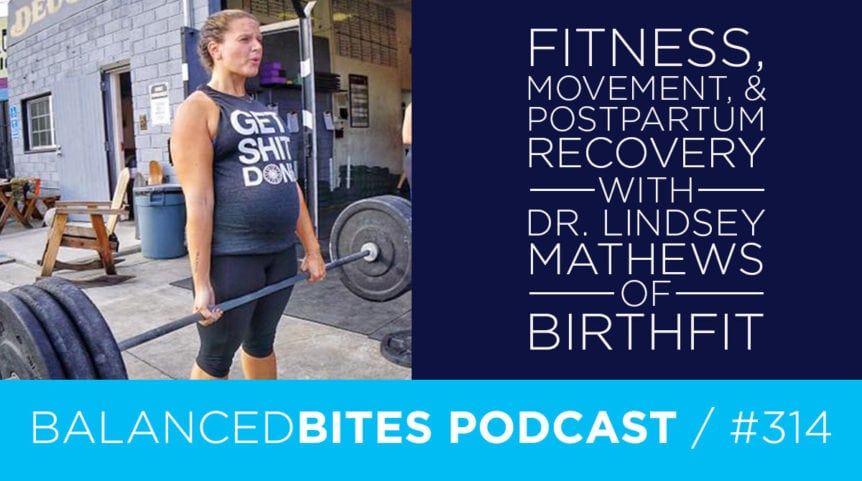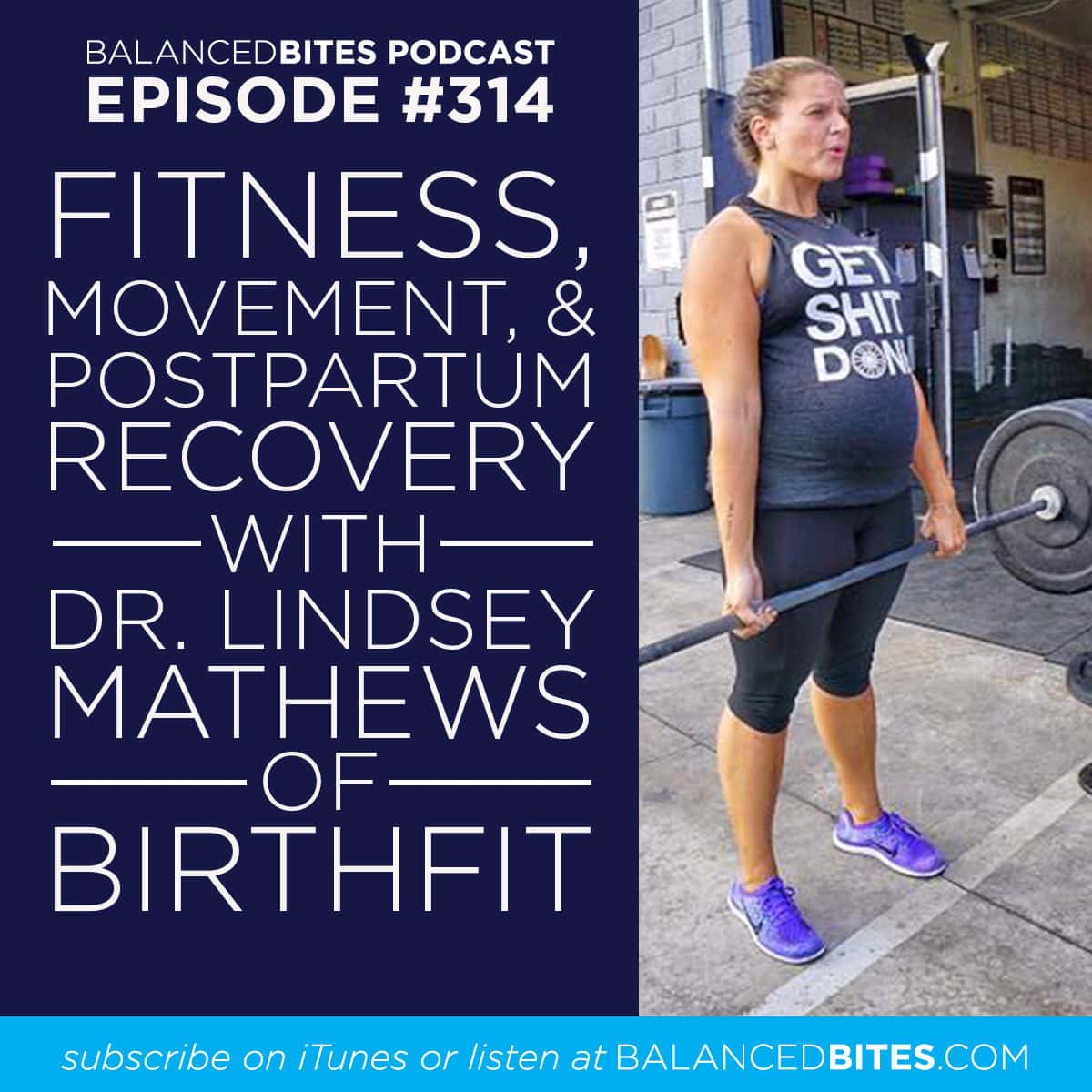 Topics
Topics
- Reintroducing Dr. Lindsey Mathews [1:40]
- Breath work [2:41]
- Emotions held in scars [8:42]
- The fitness of BirthFit [11:30]
- Foundational movement patterns [26:10]
- Cesarean versus vaginal delivery recovery [34:08]
- Rapid fire questions [38:53]
Subscribe to DianeSanfilippo.com
Check out BirthFit – http://www.birthfit.com/
The episodes are also available in iTunes, Spotify & Stitcher.
![]()
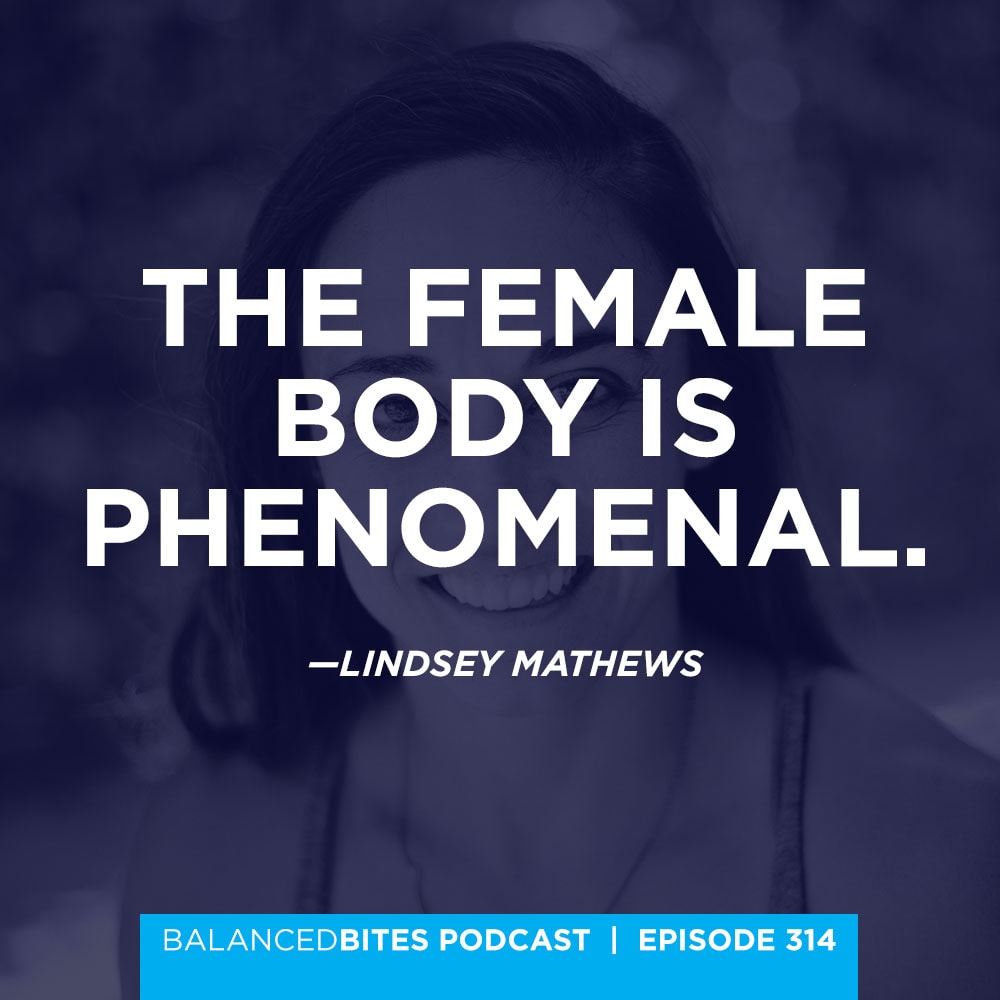
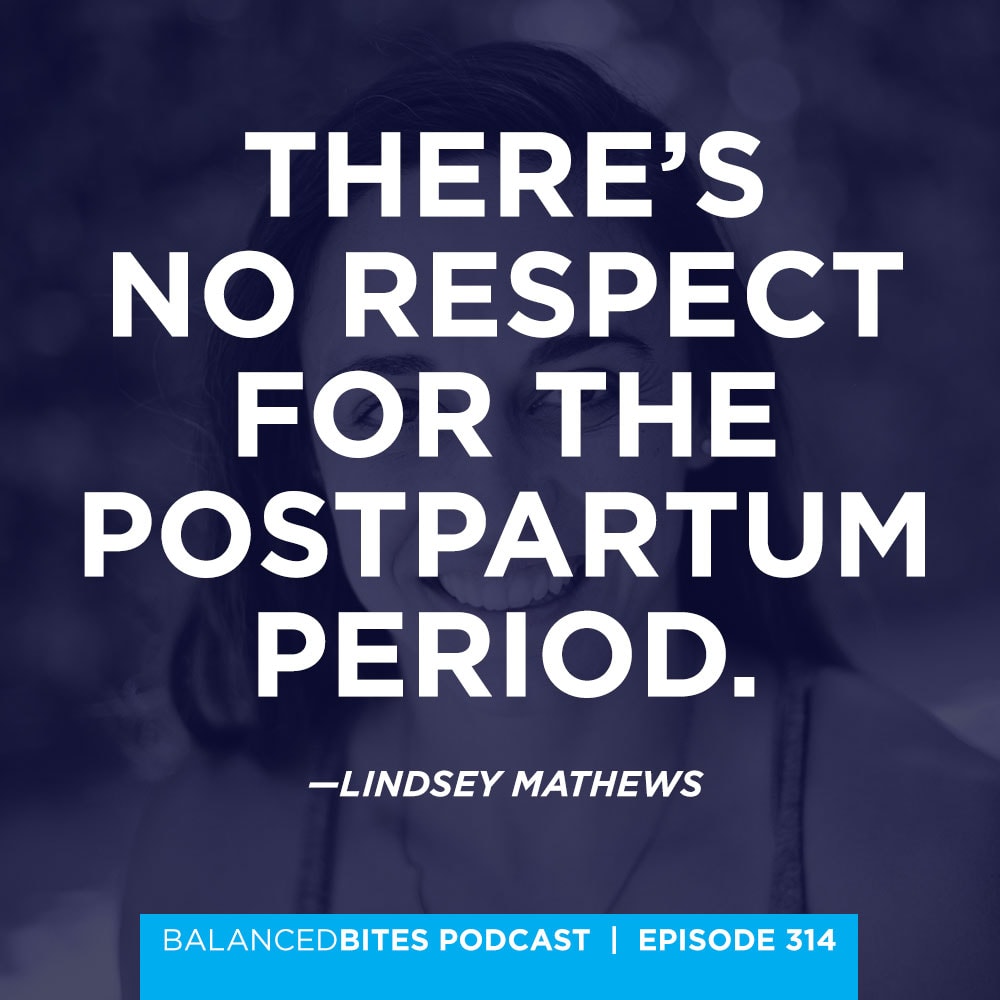
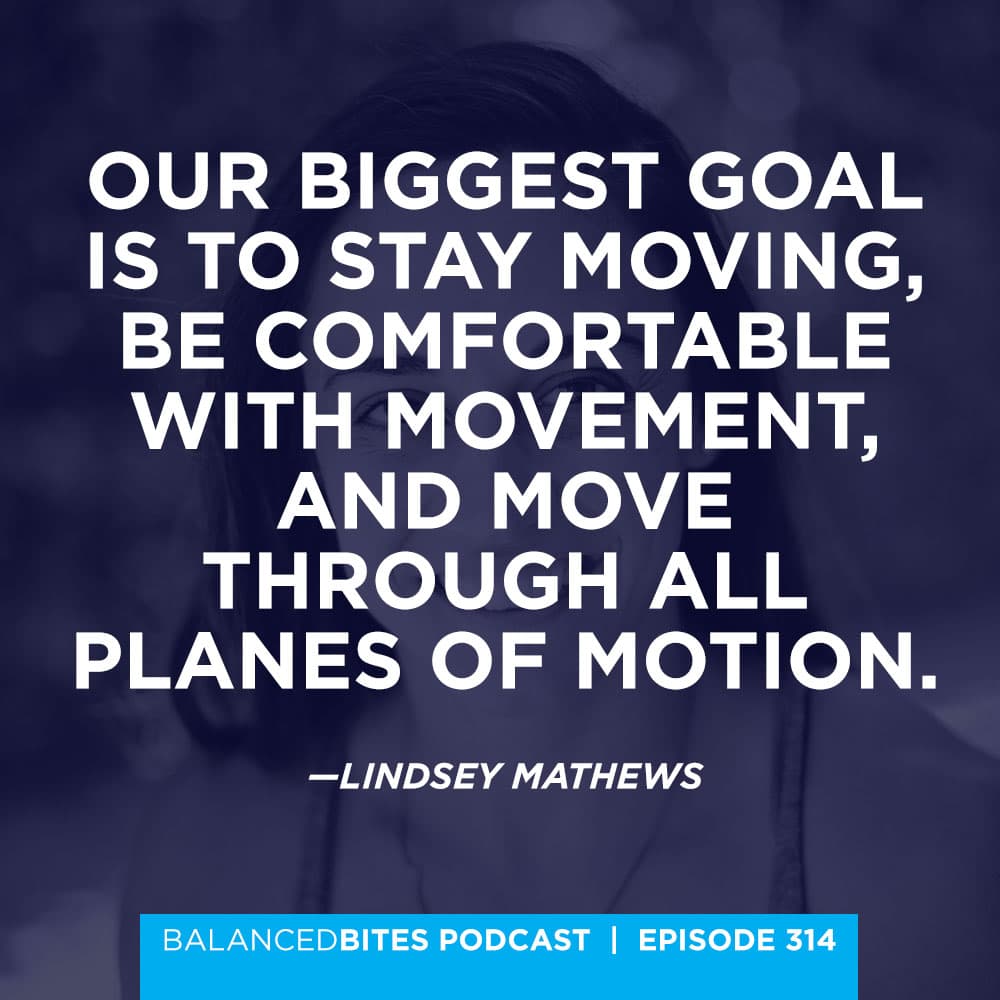
You’re listening to the Balanced Bites podcast episode 314.
Liz Wolfe: Welcome to the Balanced Bites podcast. I’m Liz; a nutritional therapy practitioner, and author of the Wall Street Journal best-seller Eat the Yolks; The Purely Primal Skincare Guide; and the online program Baby Making and Beyond. I live on a farm in the mystical land of the Midwest, outside of Kansas City.
Along with my partner in crime and usual cohost, Diane Sanfilippo, This award winning podcast has been coming at you for nearly 6 years. We’re here to share our take on modern paleo living, answer your questions, and chat with leading health and wellness experts. Enjoy this week’s episode, and submit your questions at http://blog.balancedbites.com or on our Instagram page.
Remember our disclaimer: The materials and content within this podcast are intended as general information only, and are not to be considered a substitute for professional medical advice, diagnosis, or treatment. Before we get started, let’s hear from one of our sponsors.
Liz Wolfe: The Balanced Bites podcast is sponsored in part by the Nutritional Therapy Association. The NTA trains and certifies nutritional therapy practitioners and consultants (including me; I’m an NTP), emphasizing bio-individuality and the range of dietary strategies that support wellness. The NTA emphasizes local, whole, properly prepared nutrient dense foods as the key to restoring balance and enhancing the body’s ability to heal. Nutritional therapy practitioners and consultants learn a wide range of tools and techniques to assess and correct nutritional imbalances. To learn lots more about the nutritional therapy program, go to http://www.NutritionalTherapy.com. There are workshop venues in the US, Canada, and Australia, so chances are you’ll be able to find a venue that works for you.
1. Reintroducing Dr. Lindsey Mathews [1:40]
Liz Wolfe: We are back again today with Dr. Lindsey Mathews with part 2 of the BirthFit podcast. As a reminder, Lindsey Mathews is a doctor of chiropractic and founder of BirthFit. And BirthFit is a movement that centers around supporting moms and taking charge of their bodies throughout pregnancy and postpartum, and approaching birth with all of the information. From the science, to the common sense, to connecting with our innate wisdom using tools like BirthFit’s four pillars.
We talked a little bit about the four pillars and a ton of other stuff in part one. Part two and we’re going to talk more, and we’re going to specifically center a bit on fitness, which should be really great. But if you haven’t listened to part one, definitely go back and have a listen. It was a phenomenal first part of this series, and it’s going to transition beautifully into this part, which is part two. So we’re welcoming Dr. Lindsey Mathews back once more. Let’s get into the interview.
2. Breath work [2:41]
Liz Wolfe: Ok, this reminds me. Something I forgot to ask you about that I said I was going to is about breath work. So would this be a good time for you to talk a little bit about why that’s so important to your program?
Lindsey Mathews: Totally. So, I have to say our breath connects the physical.
Liz Wolfe: Oh my god I love that!
Lindsey Mathews: {laughs} So if you want to get super science-y, or dorky, the diaphragm forms, I think it’s as early as 6 to 8 weeks in utero. Or there’s remnants of it. Then on the outside, I think the diaphragm is our first muscle that begins contracting. In a newborn. And the diaphragm is used for breathing. We fill it up with air, and if we’re working out, we use it to brace. The diaphragm and the pelvic floor kind of work synergistically together. And this is our core. I like to say, that deep down inside. That is everything. That is mind, body, soul held in the diaphragm.
There are studies out there, and I can’t remember where they are. The diaphragm houses a lot of trauma. You can hold emotions there.
Liz Wolfe: Holy crap. I just want you to know you just gave me a huge epiphany about myself.
Lindsey Mathews: {laughs}
Liz Wolfe: I’m going to mute again. Thank you for that.
Lindsey Mathews: Yeah. And I think it was two years ago, I had a brilliant epiphany where as an infant, I probably wasn’t allowed to have my diaphragm fully develop. I had crappy soy formula, antibiotics, so I wasn’t using my diaphragm to the full potential. Which, go figure, diagnosed with asthma.
But our diaphragm is really important with us. And each of our training days starts with posture and breath work. So this can be varied, but we like to spend at least 10 minutes. And this is in our online program, or any personal training we do. Or even in my chiropractic sessions or BirthFit prenatal series or postpartum series; there’s always breath work involved. And for the most part, it’s simple. We just breath in through our nose, fill up our bellies with air, and then let the ribs expand and then breath out through our nose.
That in an out through the nose helps to kind of calm the nervous system and keep that in check. But having that check in at the beginning or at the end is key to keeping your, I want to say your spine, everything in alignment and grounded with where you're at today. And in the training, we may do it seated. We may do it standing. We may do it lying supine. But in all positions, we want to have the spine neutral. So pelvis and ribcage stacked on top of each other. And lying supine is probably the easiest way to do that. Lying on your back when your knees bent, feet about hip distance apart. That’s the easiest, most comfortable way to just breathe.
If we’re using breath work to prepare for, let’s say, labor and deliver. Maybe we’re a little farther along. We may change the breath a little bit, and inhale, and breathe out through the mouth. You’ve probably heard your midwife or your doula say, “Relax your jaw, relax your face.” And we just get into that sort of breathing patterns.
We also practice some cleansing breaths. So I like to, with my clients, use a cleansing breath after each contraction. Let’s say the contraction has come and it’s gone. I’m like; Ok, take a big breath in. And we do that through our nose, fill up everything, and then just blow everything out, let it all go. Because what’s happened has happened, that’s in the past. And now we’re focusing on the next task at hand, which is the contraction that’s coming up.
And then if we are on the rehab side of things; let’s say the postpartum side. And we’re learning to connect with our soul power, our core again. Then we’re learning how to create that intraabdominal pressure. So we’re learning out to brace out 360 degrees. And for some, let’s say I have a C-section mama, and it was a bit traumatic. Having her breathe into her belly make take three weeks, and then we start practicing the bracing. Having her connect and just put her hands on her scar and breathing; that’s so powerful.
I’ve had office visits where that’s been 10-20 minutes of that, and the mom’s just crying. Releasing so much emotion that’s held in that scar. There’s a great book, I think it’s called Wild Feminine.
Liz Wolfe: Yes, I have that book!
Lindsey Mathews: So Tammy Kent. I think she’s a PT. She talks about connecting with our soul power a lot. And how our uterus holds that. And for the mom’s that have had a C-section, it’s so powerful. Even the mom’s that had a vaginal birth, learning to breathe again is difficult. But when you're in that almost traumatic fight or flight state, you're still breathing in your chest and the accessory muscles. That, like I said, could take three weeks just to get that breathing pattern back into the belly again.
3. Emotions held in scars [8:42]
Liz Wolfe: I’ll tell you; I’m kind of talking about bits and pieces of my birth story over the last couple of months. I haven’t really shared it. But for some people, it can take 2 years. Like for me to even touch my scar took about 2 years. Because I was so, so just devastated and sad about it. And a lot of what you're saying about breathing is completely; it’s me to a T. So you’ve given me a ton to think about. So thank you for that.
Lindsey Mathews: Yeah, for sure. Like I said; if there are scars on our body anywhere, they hold emotion. I’ve got scars all over that, for me, some of them have taken years to touch or move or just be connected with an accept again. And accept that part of my body again. But that’s so powerful, is just being able to touch and breathe into that, and send energy there. That’s one of the biggest things I would say for anybody with a C-section.
Liz Wolfe: The hardest thing, I think for me about that. Is how deep the scars go. It’s not just; from the surface. They cut many layers to get in there, and it goes so deep. It’s hard to imagine just where to go from there. I’m sure a lot of mom’s kind of know what I mean about that, but you’ve definitely given some amazing tools that I think most women have never even heard of for that, so thank you.
Lindsey Mathews: For sure. And even; like you said, you may not know where to go or what to do next as far as healing. But if you come into it with kind of an open mind, let’s see what happens. See what comes up. And like I said, some women will automatically fill with tears. I’ve had one that kind of just started giggling. And she’s like, “This is what I do when I’m nervous.”
Liz Wolfe: Yeah.
Lindsey Mathews: But your body will tell you, I think, what it needs next. And it could be anything, you know. So I think just be open to that, for sure.
Liz Wolfe: Yeah.
Liz Wolfe: Today’s podcast is sponsored by Vital Choice seafood and organics. Purveyor of premium sustainably sourced seafood and a certified B corporation. Vital choice offers a wide range of fish, shellfish, humanely raised meat, protein rich bone broths, and paleo friendly snacks like organic dark chocolate, super antioxidant trail mix, and bison jerky. As the days get longer and the grilling season heats up, www.vitalchoice.com is your source for real food.
4. The fitness of BirthFit [11:30]
Liz Wolfe: Ok. So it’s called BirthFit, so we need to talk a little bit about fitness before.
Lindsey Mathews: A little bit, huh?
Liz Wolfe: Yeah. Man, I am not good at these shorter podcasts, I’ll tell you what.
Lindsey Mathews: {laughs}
Liz Wolfe: So maybe we can make this a little bit rapid fire.
Lindsey Mathews: For sure.
Liz Wolfe: Which is hard to do, because topics like pelvic floor and diastasis rectus abdominis, right?
Lindsey Mathews: {laughs} Yeah.
Liz Wolfe: Those are not sound-bite issues.
Lindsey Mathews: {laughs}
Liz Wolfe: But we’ll do our best. So you talk; ok, the pillar of fitness you say is to functionally train in a way that develops competencies in physical skills as well as enhances the three main metabolic pathways. Can you expand on that a little bit?
Lindsey Mathews: Yeah. So, we like to be well rounded fit to prepare for the unknown. And the unknown for us, specifically, is birth. And it can be vaginal or cesarean. So, you know, my work with athletes or stunt people or whatever; at whatever particular moment we were in, we were training specifically for something. So, that’s what we’re training. We’re training for birth.
You need strength, you need endurance, you need range of motion, you need stamina. You need to have this well-rounded fitness. But also be respectful of the female body, and that it’s going through changes. And you may not be the same athlete that you were 6 months prior to conceiving. Or even a year postpartum, you may be an even better athlete. Who knows? But our specific is training for birth and rehabbing from birth.
So, if you look at the prenatal body; you're pregnant. It’s like, fully pregnant once you conceive. There’s no sort of or maybe, or halfway. It’s fully pregnant. Mom’s going through all these physiological changes. Her body is adapting. I mean, the female body is phenomenal. And by the end of pregnancy, she’s become this super hero. Her blood system is totally efficient. Anybody that performs on the Olympic level would equate it to blood doping. Just because her body has become just so freaking awesome at being pregnant and being the most optimal version of herself. So, I like to say that. Because for the most part in our society. And I think times are changing. But we view pregnant women as these fragile beings. And they’re not. They’re freaking warriors.
Then on the other side, on the postpartum side, we have these unreal expectations for women to either get their prebaby body back, lose the weight, come back to work, be the vice president that she was 3 months ago. And it’s just unrealistic. There’s no respect for the postpartum period. So if I could say that in general; the pregnant woman is amazing, a super hero, and let’s respect the postpartum period. At least for the first year, because we’re not doing any of that. And postpartum lasts forever.
So that said, we go through changes. And you can stop me at any point.
Liz Wolfe: No, I love this. If you have time, I have time.
Lindsey Mathews: {laughs} We start training intentionally. So I’ll give you an example of what some of our training days look like. We use a similar method to the conjugate programing. I don’t know if anybody has heard of conjugate that’s listening, but it’s a powerlifting type of programming approach. And I was exposed to this; I forget. A few years back. And I was blown away not only by how much weight these guys lifted; girls, guys, everybody involved. But also the injuries. They were not there. Tendinitis, tendinosis. Anything like that. I was like, whoa, what’s going on here? You haven’t had an injury in 9 years? What? {laughs}
So I just kind of dug deep into that more. I made a similar approach for BirthFit. And we also use a similar method to the conjugate method. But we also use DNS and developmental kinesiology principles. DNS stands for dynamic neuromuscular stabilization. And that’s brilliant. Because if you know anything about pregnancy, you’ve probably heard the term relaxin, which is a hormone that’s elevated in a woman’s body during the first trimester. And then again more so at the end of the third trimester as labor approaches; birth approaches. So ligaments become a little bit more lax.
DNS, their focus is stabilization through all joint range of motion. Moving through natural, innate movement motor patterns. So all that said, we put that into weeks, days, months programming. A typical day or week may look like a lower body focus on Monday, an upper body focus on Tuesday. Rest day on Wednesday, lower body Thursday, upper body Friday.
And then if you want to get super specific, let’s say on Monday we start with posture and breath work. And that’s about 10 to 15 minutes. And if we’re at the beginning of pregnancy, maybe weeks 8, 10, 15. This may be breathing lying down on the ground or standing. Even seated on a block. If we get further along in pregnancy, like weeks 32, 35, then we may do 5 minutes of seated breathing and then incorporate breath with some hip circles, leaning up against the wall. Starting to get some of those movement patterns familiar so that mom can use those during labor.
And then after the breath and the posture check in, we do the functional progression. And right now, we have the functional progression broken down into part 1, part 2, part 3, and part 4. And I could tell people, these are your daily movement vitamins. This is your check in with your body. And we all do it. I do it every day. And we do about 5 to 10 reps of each movement. You incorporate your breath, and your intrabdominal bracing, and you feel where your body is at today. And there are days when I do the functional progression, I’m like; “Oh, yes. I can deadlift the house today.” And other days when maybe I planned on working out or going to the gym, I’m like, “You know what? It didn’t feel quite right. I’m going to go for a longer walk today.” And that’s the tools that we hope to give women who are doing the program, as well. Hey, this is your check in. I need you to be in tune with where your body is at today. Because during labor and delivery, during birth, you and birth are the only ones with guaranteed tickets to the show. So you’ve got to be comfortable with who you are. And moving through space. So that’s a functional progression.
Then we get into kind of a two-round, for quality work. And these are usually movements that will prime the body for whatever strength work we’re doing that day, or warmup for the conditioning part of the day. So let’s say we’re working on sumo stance box squats for strength. Then we may do some single leg box squats. We may do some hip hinge plate slides. We may do some banded good mornings. All that would be in the for quality warmup stuff.
And then we get into the strength portion. And I usually have it set up where it’s usually 12×2 or 9×3 or an EMOM. And the biggest I would say bold font I say is we only take lifts that we know we will make. And very rare do we play in the range above 80%. But occasionally, I may have a mom that’s like, “Oh, I’m feeling pretty good. Can I try this.” And I’m like, if you know you're going to make it, then yes. And the reason for that is, there’s no room for a musculoskeletal injury during pregnancy. Pregnancy is short. It’s only 40 weeks. So if you have a musculoskeletal injury, even a disk injury, that’s going to take time away that you’ve got to focus on an injury. And it’s also going to bash your confidence and bring you down.
So we only take lifts we know we will make. We only deadlift what we can also stand up. And that confidence that you gain in the gym is also carried over into everyday life. And into the birth scene. So that would be strength. And then you get into some conditioning.
Conditioning is usually; there’s one or two longer ones. Like 20 to 30 minutes during the week. There’s usually some interval ones that maybe 60 to 90 seconds with one to two minutes rest. There may be some flow type of session. Like, hey this is an 18-minute flow. These are the four movements. Go through them at about 70% of your perceived exertion.
And do the interval stuff; that’s pretty relatable to contractions. Like, contractions at the most last 60-90 seconds, and at the peak there will be maybe 10 to 15 seconds of extreme discomfort. The whole 60-90 seconds is probably relatively uncomfortable. But the peak of it is at the most 10 to 15 seconds. And we start putting that in mom’s minds, in the training. “Hey, let’s breathe through this interval. It’s related to the contraction. We’ve got rest coming.” And then when she hits the rest, “Ok, let’s take a big cleansing breath and let it all out. Forget what just happened and let’s move onto the next interval.” Or relating it to a contraction, the next contraction.
And then we finish the day with some accessory work. Accessory work is usually something that will enhance either the strength portion of that day. And it could be; again, it could be 100 banded good mornings, or it could be banded triceps extensions; also range of motion stuff, like ok chest opener. Big hip mobility day. And then as we progress through pregnancy, there’s a lot of stuff for hip mobility; ball circles. Things like that to get mom familiar with some movements that she may not even think of, but would be so useful during labor and delivery.
Our biggest goal is to stay moving, be comfortable with movement. Move through all planes of motion. Because all of that is going to be needed when you labor. Labor does not happen in one plane of motion. You don’t know how long labor is going to be, so you definitely need some endurance and stamina. And you want to be familiar with the movement. So, you're doing lunges, and at some point you're like; “when I lunge with my left foot forward, that kind of hurts my groin but the right is fine.” Don’t avoid the left side, figure out why that’s going on. Because most of the time, something is off in your pelvis and that’s where chiropractic can come in and that can help for sure. Everything we do is pretty focused and with the end result being birth. We’re training for birth.
Liz Wolfe: This episode of the Balanced Bites podcast is sponsored by our friends at Primally Pure Skincare. Primally Pure makes 100% natural and nontoxic skincare products that support radiant skin, a healthy body, and a happy self. They use ingredients like tallow from grass-fed cows; organic and fair trade coconut oil, and organic oils, herbs, and extracts to formulate effective products that also smell amazing and look beautiful sitting on your bathroom counter.
At www.primallypure.com, you’ll find their bestselling natural deodorant that actually works; face mists made from locally sourced and organic rose and orange blossom hydrosols, and their brand new baby line. You’ll also find Diane’s favorite Primally Pure product, dry shampoo, and Liz’s favorite, that’s me, the Everything Spray with magnesium.
As a special bonus for you, Primally Pure is offering a free lip balm with your first purchase of one item or more. Simply add a lip balm to your cart along with any one item, and use the code “balancedbites”, one word no caps, during checkout to receive one of their lip balms for free with your order. Head to www.primallypure.com and check out their range of safe and effective all natural skincare products.
5. Foundational movement patterns [26:10]
Liz Wolfe: I love that idea. My next question was, you talk about foundational or fundamental movement patterns. And I feel like you just pretty much covered that. Do you have anything more to say on that, that I should go ahead and ask the question?
Lindsey Mathews: This will probably lead into some stuff. One of the, I guess, speeches or talks we give at the BirthFit coach seminar, even the professional seminar and the summit, is all about human movement. And how we’re connected through movement. And if you were to put a baby on a blanket in Japan, and a baby on a blanket in Wisconsin, a baby on a blanket in Prague, they would all learn to move the same way.
Liz Wolfe: Oh, I love that image.
Lindsey Mathews: Yeah. So if you go, and ideally. Uninterfered, society is not messing with them, and putting them in a jumper or something.
Liz Wolfe: Yeah. Because we see a lot of times moms say, “How do I teach my baby how to walk? How do I teach my baby how to roll over?” You don’t have to teach them anything. It’s in there.
Lindsey Mathews: Yeah. They got it! {laughs}
Liz Wolfe: Yeah.
Lindsey Mathews: They’re probably going to be better than you if you just leave them alone.
Liz Wolfe: Totally.
Lindsey Mathews: Yeah. And it starts with; so our functional progression one is related to baby’s starting to see their hands, move their feet. And they’re learning to stabilize their spine against gravity. And this may, this is hard to see, but every part of their spine is touching the earth or the ground. So they’re pretty stable. They have their hips; each of the hips touching, each of their shoulders touching, the spine touching. But then when they learn to roll over, and this is where our functional progression two comes in. They are getting a little more uprighted. I’m bad at English, too; I speak Texan.
Liz Wolfe: {laughs} That works.
Lindsey Mathews: {laughs} They’re up on an elbow, or on a knee. So there are less points of contact. So they have to stabilize more through their midline. And it starts with the diaphragm. And then it extends from there. All movement is definitely from core to extremity.
Liz Wolfe: Wow. I was in a lot of jumpers as a kid, FYI.
Lindsey Mathews: Me too.
Liz Wolfe: A lot.
Lindsey Mathews: Me too. {laughs} And then when you roll over completely into that crawling position, then as you crawl you basically have two points of contact. You’re lifting up one arm, one knee, and then groin. And then the other arm, the other knee, and then groin. And then when you learn to stand. Let’s say, if you watched your kiddo or whoever, and they put their booty in there. Their hands are on the ground, they’re like, “Oh my god, this is so far away from the ground!”
Liz Wolfe: {laughs}
Lindsey Mathews: So then they squat. And then they’re looking around. So they may embrace the squat for a while. Or they may embrace what we call tripod, or the lunge. Where one leg is up. And then they grab furniture. And they use the furniture to scoot around the room. And they still have contact and stabilization. But all kids are going to go through that phase; or those milestones.
So, in our postpartum series, in the postpartum series, we have to take it back to that. Because babies are born with diastasis. They’re born with ab separation. And it closes around 6 to 7 months; or whenever they learn to roll over. And they’re starting to incorporate those crossbody movement slings or anatomy slings. There’s a great book called Anatomy Trains that talks about all of this.
But that’s when baby’s ab separation starts to approximate and come together. And they have to be able to roll both ways. So in our postpartum series, that’s what we do. We learn to move like baby, with baby, and watch baby. That’s the answer too. People always ask me, “How do I heal my diastasis?” I’m like, “Well, you’ve got to learn to move like your baby.” They’re like, “What?”
Liz Wolfe: Yeah.
Lindsey Mathews: “Can’t I just do these three quick exercises?” I’m like, “Well what are they?” then I see them an I’m like, no.
Liz Wolfe: It’s kind of like Kegels for pelvic floor.
Lindsey Mathews: Yeah!
Liz Wolfe: It’s just not the {laughs} it’s just not the approach.
Lindsey Mathews: Yeah! You’ve got to incorporate the whole system. And if you're not creating intraabdominal pressure, and breathing, and moving, then the link is out somewhere. The gig is up somewhere. So yeah, we can break it down, like the bear position and breathing and creating that intraabdominal pressure will help the pelvic floor. But if you can’t move through and transition into bear and transition out of bear, then how are you going to translate that into your everyday life? You move using these innate motor patterns all the time. But on a grander scheme. So it’s got to come back, and you’ve got to reestablish the foundation in that postpartum period.
I think it actually was Melissa who wrote this blog a while back that was like, “Use this as an opportunity to reset, reestablish, recalibrate yourself. When else would you ever do that in your life? Especially as a mom or an athlete, whatever you identify with. Give yourself space to ground yourself, set the foundation, and learn to move again properly.
Liz Wolfe: Well this is so much of what I love about what you do. And you’ve talked about this on your podcast, you’ve talked about this on the BirthFit website. It’s so unusual to have a fitness and wellness oriented practitioner who is not like, “Wait until 6 weeks postpartum and then you can start working out.” We’re just; I feel like a lot of moms are waiting to be cleared to run again.
Lindsey Mathews: Yeah.
Liz Wolfe: Or jump right in and do something really intense again to “get their bodies back” or whatever it might be. But a huge part of your approach is; you are just feeling for when that readiness is there and you're being careful and you're treating people as individuals. And the beginning has nothing to do with deadlifting and squatting. It’s like, breath work, and these functional movements that you're talking about. The fundamental movement patterns and stuff like that. Do people come to you like, “Ok, but wait. When can I run 10 miles and squat?”
Lindsey Mathews: {laughs} Yeah. For sure. {laughs} And I’ll have to put limits on people. And I know the ones for the most part. But I’m thinking of this one that just had her second baby. And she loves fitness. She’ll do CrossFit, anything, endurance, something every day of the week if she could. And I was like, “You're not allowed to call us,” me or Emily, who is the coach who does the BirthFit Los Angeles. I’m like, “You're not allowed to call us for 4 weeks. You're on a time out for 4 weeks.”
Liz Wolfe: {laughs} You’re on a time out.
Lindsey Mathews: {laughs} I was like, the only thing you can do at home is breathe. {laughs}
Liz Wolfe: I love that. I absolutely love that.
Lindsey Mathews: But yeah, there are those out there.
6. Cesarean versus vaginal delivery recovery [34:08]
Liz Wolfe: Well I’m not one of them. You wouldn’t have any problems with me. I can breathe. You're giving me so much to work on, and I’m so grateful for how much time you're giving us here. If I could just ask a couple more fitness and movement related questions.
Lindsey Mathews: {laughs} Yeah.
Liz Wolfe: And we’ll let you live your life again, since we’ve been on Skype for about two hours. Let me pick what I really want to talk to you about. I think we’ve talked a little bit about cesarean recovery. But can you tell me how that might look different for a cesarean mom versus a mom who has had a vaginal birth?
Lindsey Mathews: Yeah, for sure. So, I don’t know if you know this, but cesareans are one of the top surgeries in our country. And for sure the number one abdominal surgery. OB/GYNs are really good. They’re really skilled at these, because they learn this in school and they practice this all the time. But, this is a surgery. And you have to let your body recover appropriately.
For instance, the easiest example I can give is my knee surgery. I was on crutches for 2 weeks. I was not allowed to put weight on my leg for 2 weeks after that surgery. So for those are that like, “Hey I’m 2 weeks, back in the gym!” I’m like, holy sh*t. Pump your brakes. You know? I don’t know what’s going on with your insides.
The soft tissue, the ligaments, the muscles, stuff like that. Especially the ligaments. It can take an average of 280 days to heal. That’s like, I want to say, 6 months at least if I’m doing math correctly. A lot of this stuff, you can’t even see. So whether it’s a cesarean or a vaginal. Even though you wake up one day and you may feel great, try a 10-minute walk and see how you feel. The next day you may have some bleeding or even with a cesarean, a lot of mom’s may feel tugging or pulling on their scar. Just be aware of that, and give yourself that space to heal some more.
But for the cesarean moms, 6 weeks I would say is not nearly enough. Definitely the breathing and stuff. I’ll give all mom’s, as soon as I see them. But I meet them where they’re at. We talked about earlier; it may just be learning that abdominal breathing pattern again. And then we meet again at 8 weeks postpartum, not the 6 weeks. Because the cesarean, that’s a major, major abdominal surgery.
I will add that, I was just in a conversation with somebody about this the other day. I forget where this was. But somebody was saying, “I support cesareans because they don’t damage the pelvic floor.”
Liz Wolfe: Yikes.
Lindsey Mathews: I’m like, that is a false statement.
Liz Wolfe: Wow.
Lindsey Mathews: {laughs} That is a false statement, and I wanted to say that because I’ve heard it more than twice this week. And I’m like, “Whoa, where are we going with this?” No. Actually, there is no correlation that it will actually prevent damage to your pelvic floor. The damage to the pelvic floor is usually done from episiotomies, and forceps, and tools used. So just keep that in mind.
Liz Wolfe: I can definitely vouch. I had to do; I went to a pelvic floor physical therapist relatively recently. Because I was definitely told that with a cesarean birth, there’s no concern about the pelvic floor. Nobody told me. Well, thankfully I wasn’t told to do Kegels. Because, that’s just a bad idea really anyway. But I was never told that this was something to look out for. Then months and months down the line, I start to realize that I have some stuff that needs to be dealt with. Like pregnancy, right? {laughs} Pregnancy is a force on your pelvic floor. So yeah, everybody should see a pelvic floor physical therapist.
Lindsey Mathews: For sure. For sure.
38.19
Liz Wolfe: That was great. One of the things that we’ve talked about during this podcast is, we’ve talked about scars and we’ve talked about movement patterns. My first entry into this world of, “Wow, your scars can really influence parts of your body that you had no idea were connected via your movement patterns.” I think my first exposure to that was through neurokinetic therapy. But it’s so true how your scars impact how you move.
Lindsey Mathews: Yeah.
Liz Wolfe: Fascinating.
Lindsey Mathews: Yeah, it’s wild.
38.53
Liz Wolfe: Ok. So let’s go through a couple of rapid fire questions here.
Lindsey Mathews: Ok.
Liz Wolfe: But I just want to remind everybody, pelvic floor talk or diastasis rectus abdominis. I always say it wrong. Will you say it, please, Lindsey?
Lindsey Mathews: {laughs} Diastasis rectus abdominis.
Liz Wolfe: Thank you. Either of those topics, you must. No matter what your practitioner tells you, do lots of research. Because the conventional wisdom is really not addressing the roots of the problems that women have. Let’s just put it that way.
Lindsey Mathews: Yeah.
Liz Wolfe: So go to BirthFit.com and read up. Alright, so a couple of rapid fire questions here for you. I think you’ll like this first one. And by that I mean hate it.
Lindsey Mathews: {laughs}
Liz Wolfe: Should pregnant women squat below parallel?
Lindsey Mathews: {laughs} Yes. The only time I will say; eh. Let’s maybe not squat all the way down. Is if I’m dealing with a mom, and she has a breech baby and we’re trying to flip breech baby. And that may be just for a week. Another one may be the placenta previa. So in general, I would say most women should be able to squat below parallel. Because it’s a functional movement.
Liz Wolfe: Ok. Now, if you're not regularly squatting prior to pregnancy, can you start when you’re pregnant, or does it depend on the load that you're carrying?
Lindsey Mathews: Yeah. Yeah. Definitely. We’ve had mom’s join. They want to be BirthFit at like 35 weeks, or whenever you know. But we usually start them squatting to a box. And if you go on YouTube, there’s something called the postpartum box squats. And that’s what we do with anybody that maybe has not been squatting, or squatting below parallel or any kind of; that’s just a really good place to start. Is squatting to a box.
Liz Wolfe: Ok. So this is the second to last rapid fire; should postpartum women avoid crutches? And this ties into the DRA conversation. Let’s just address crunches.
Lindsey Mathews: Yeah. Yeah. I’m not a big fan of crutches, or sit ups. I don’t think we do enough in our training. Maybe you do, I don’t know, but I know I don’t. Enough on the backside of my body; like spinal extension. Superman stuff like that, to counterbalance if I were to do all the crunching or sit-ups. If it’s programmed at the gym, like once in a blue moon. Hey, do 30 sit-ups, I’m always the one not doing it. I’ll find something else. And they’re like, “What are you doing?” I’m like, “Don’t worry about it. I’ll figure it out.” {laughs}
But yeah. The sit-ups, especially the crunches and things like that. If you're not going all the way up in the sit up, that’s another thing. There is always a way we can find that the sit up can work. You create intraabdominal pressure, keep your spine in alignment and rise up that way; sure. But I’ve only seen one person be able to do that. So for the most part, it puts a lot of pressure, a lot of stress, a lot of exertion on the rectus abdominis, which is our 6-pack muscle. That one that makes all the abs that you can see on some people. And if you're only working in that plane, you're not working anything that’s helping to approximate the abs from the top down, left to right. You're only working basically that sagittal plane movement.
Liz Wolfe: Got it. Ok. Final question. This is one I asked of Katy Bowman, and I’ve been dying to ask you. If somebody assaulted you in the grocery store. If somebody recognized you, and was like, “Hey, Lindsey Mathews. What do I need to do for a healthy pregnancy?” {laughs}
Lindsey Mathews: {laughs}
Liz Wolfe: And you literally had; you knew you’d never see this person again but you wanted to leave them with something, what would you say?
Lindsey Mathews: Oh.
Liz Wolfe: You can think about it. We’ll cut the silence out. {laughs}
Lindsey Mathews: No, definitely. I would tell them. “Hey, you need to start an awareness practice.” And this can be meditation, anything. 10 minutes a day, start that now. And one of my phrases is, just do you. And through that practice, you have to learn to do you in the most you way possible. {laughs}
Liz Wolfe: Alright. I like that. That will give them something to chew on on the way home from the store.
Lindsey Mathews: {laughs} They’re like, how do I breathe? What?
Liz Wolfe: Wait, I didn’t even know. I thought this was just automatic. Which is kind of the point, right? Realizing what a tool your breath is. Pretty amazing.
Lindsey Mathews: Yeah. I like to tell women, you have three things available during labor and delivery. Your breath, sound, and movement. So as we chop through some of the birth plan worksheets and preferences and stuff like that. And I walk them through, like, “Hey, if you're going to make the choice for epidural, realize that something like movement is going to be taken away from you.” So breath, sound, and movement are your tools available for birth. Use them.
Liz Wolfe: Amazing.
Lindsey Mathews: Yeah.
Liz Wolfe: Well I think we can wrap it up there.
Lindsey Mathews: Awesome.
Liz Wolfe: Thank you so much for all of the time you’ve given us today.
Lindsey Mathews: You’ve got it.
Liz Wolfe: This has been so great. We really appreciate it. Tell folks where you would like them to find you.
Lindsey Mathews: Yeah. We’re at BirthFit.com. We’re at BirthFit on Instagram, and BirthFit on Facebook. We’re also on Twitter, but I’m really bad about that.
Liz Wolfe: Yeah, me too.
Lindsey Mathews: BirthFit everywhere. {laughs}
Liz Wolfe: You're on all the platforms.
Lindsey Mathews: Yeah.
Liz Wolfe: Ok, perfect. And you’ve got PDFs, you’ve got webinars, you’ve got seminars.
Lindsey Mathews: Yeah.
Liz Wolfe: You’ve got all kinds of resources. Whatever it is, however people like to consume this stuff, they can find a way at your website.
Lindsey Mathews: Totally. And we are; I will say this. You’ll be the second person I’ve told. And then everybody else. {laughs} We are opening the BirthFit summit one day to general public next year, and it will be in Austin, Texas. So it will be like a women’s health rally, which will be pretty rad.
Liz Wolfe: Awesome. I will do everything I can to be there.
Lindsey Mathews: Yes. We’ll get you there.
Liz Wolfe: You're inviting me, right?
Lindsey Mathews: Yeah. Come on.
Liz Wolfe: I am the general public, so I get to go, right?
Lindsey Mathews: {Laughs} Yes.
Liz Wolfe: Ok, awesome. That’s really exciting. And Austin is amazing, too. So that will be fun.
Lindsey Mathews: Love it. Yes. Well thank you.
Liz Wolfe: Thank you so much. That’s it for this week then. You can find me, Liz, at http://realfoodliz.com/ and Diane at http://dianesanfilippo.com. Join our email lists for free goodies and updates that you don’t find anywhere else on our website or on the podcast. While you’re on the internet, leave us an iTunes review. See you next week.

